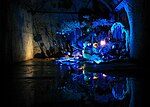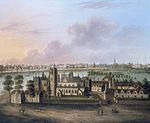Union Jack Club
1904 establishments in the United KingdomBuildings and structures in the London Borough of LambethClubs and societies in LondonMilitary clubs and societiesMilitary of the United Kingdom ... and 3 more
Organizations established in 1904Residential skyscrapers in LondonSkyscrapers in the London Borough of Lambeth

The Union Jack Club is an Armed Forces Club in central London, England, for enlisted members and veterans of the British Armed Services and their families. Located near London Waterloo railway station, the club has over 260 rooms for accommodation (singles, twins, doubles, fully accessible, family, suite and flats), restaurant, bar, small library, and a full range of meeting and banqueting rooms. The club's main entrance is in Sandell Street off Waterloo Road, opposite Waterloo station. Many guest bedrooms on the upper floors have views over London.
Excerpt from the Wikipedia article Union Jack Club (License: CC BY-SA 3.0, Authors, Images).Union Jack Club
Sandell Street, London Lambeth (London Borough of Lambeth)
Geographical coordinates (GPS) Address Phone number External links Nearby Places Show on map
Geographical coordinates (GPS)
| Latitude | Longitude |
|---|---|
| N 51.503611111111 ° | E -0.11083333333333 ° |
Address
Union Jack Club
Sandell Street
SE1 8UJ London, Lambeth (London Borough of Lambeth)
England, United Kingdom
Open on Google Maps











